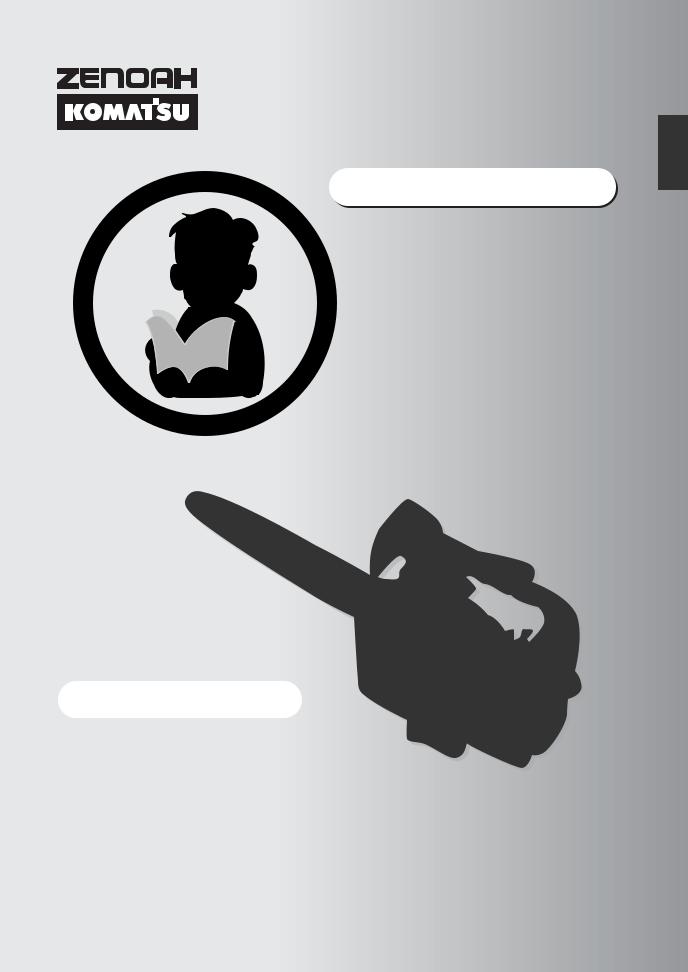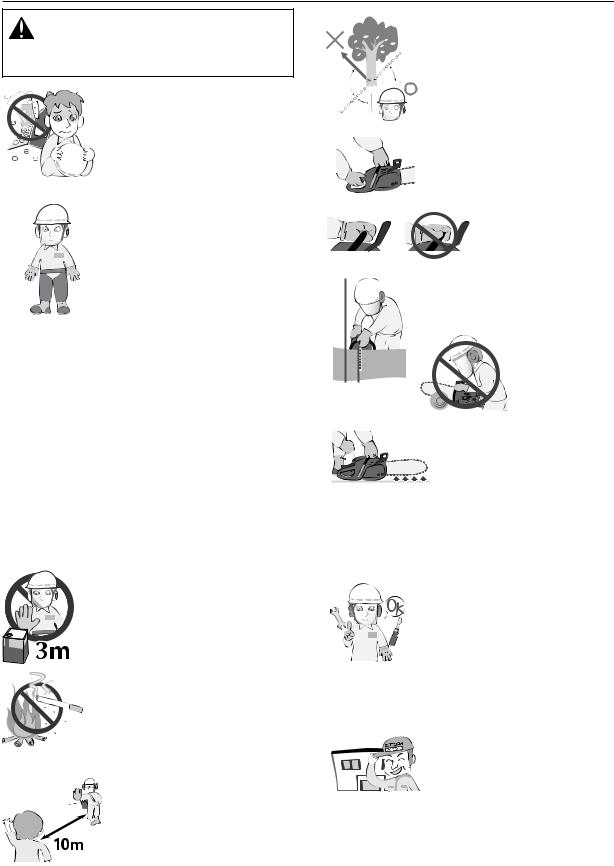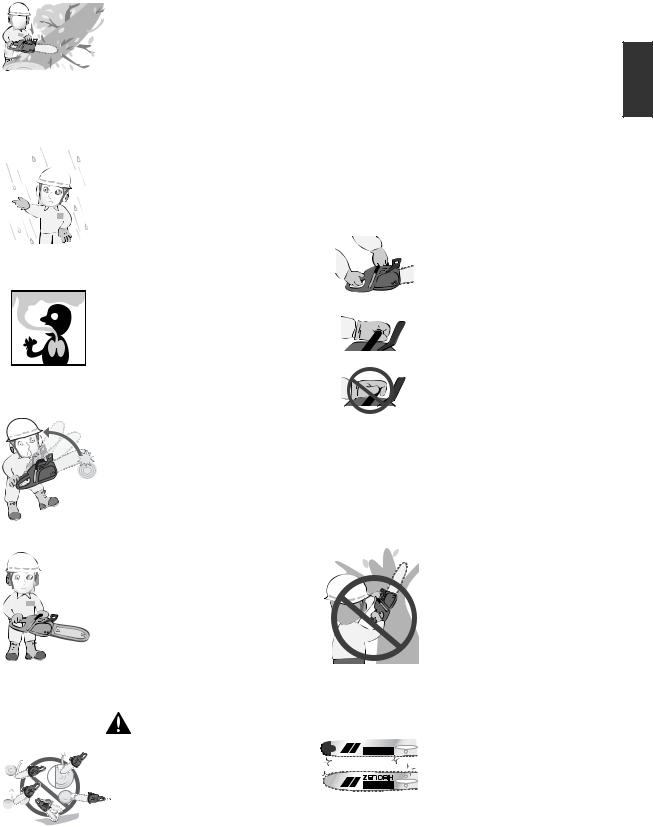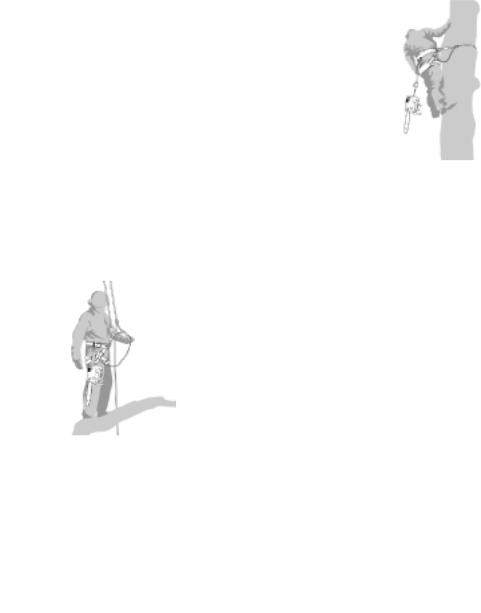Zenoah G2500 User Manual

G2500
OWNER’S MANUAL
G |
B |
CHAIN SAWS
G2500
GB-1

G2500
EXPLANATION OF SYMBOLS AND SAFETY WARNINGS
Read operator's instruction book before operating this machine.
Use the chain saw with two hands.
Read, understand and follow all warnings.
Wear head, eye and ear protection.
Warning! Danger of kickback.
Use appropriate protections for foot-leg and hand-arm.
This saw is for trained tree service operators only.
WARNING!!!
RISK OF DAMAGING HEARING
IN NORMAL CONDITIONS OF USE, THIS MACHINE
MAY INVOLVE A DAILY LEVEL OF PERSONAL EXPOSURE TO NOISE FOR THE OPERATOR EQUAL TO OR GREATER THAN
85 dB(A)
MODEL |
SOUND LEVEL |
VIBRATION LEVEL |
||
|
EN 608-ISO 7182 |
2000/14/EC |
EN608-ISO 7505 |
|
|
LpA |
LwA |
Front handle |
Rear handle |
|
guaranteed |
|||
|
|
|
|
|
25.4 cm3 |
97.4 dB(A) |
110 dB(A) |
4.3 m/s2 |
7.0 m/s2 |
APPROVAL NUMBER OF CE EXHAUST EMISSION REGULATION (2002/88/EC) e13*97/68SH2G3*2002/88*0085*00
GB-2

DECLARATION OF CONFORMITY TO MACHINES DIRECTIVE
(Directive 98/37/EC, 89/336/EEC)
and to the regulations governing transposition Internal control production
MANUFACTURER : KOMATSU ZENOAH
No. 9, 1-Chome
MINAMIDAI, KAWAGOE City
SAITAMA, JAPAN
DECLARES THAT THE DESIGN OF THE MACHINE DESCRIBED BELOW:
Model |
: G2500 |
Serial no. |
: 100101 and up |
Maker |
: KOMATSU ZENOAH |
CONFORMS TO THE REQUIREMENTS OF THE MODIFIED MACHINES DIRECTIVE (Directive 98/37/EC) AND TO THE NATIONAL REGULATIONS GOVERNING ITS TRANSPOSITION ABROAD: AND
THAT IT HAS BEEN ISSUED WITH A “CE” CERTIFICATE, NO. M. 0303. 02. 2737-08/02
BY THE ISTITUTO CERTIFICAZIONE EUROPEA PALAZZO DEL VESCOVO - V. GARIBALDI, 20 40011 ANZOLA DELL’ EMILIA - ITALY
Signed in Saitama, Japan |
1st September 2001 |
|
|
Isamu NAKAZATO
General Manager, Quality Assurance Department
G2500
G |
B |
Contents |
|
|
1. |
For Safe Operation ................................................................... |
4 |
2. |
Explanation of Symbols on the Machine .................................. |
8 |
3. |
Installing Guide Bar and Saw Chain ......................................... |
9 |
4. |
Fuel and Chain Oil .................................................................. |
10 |
5. |
Operating the Engine ............................................................. |
11 |
6. |
Sawing .................................................................................... |
12 |
7. |
Maintenance ........................................................................... |
14 |
8. |
Maintenance of Saw Chain and Guide Bar ............................ |
15 |
9. |
Troubleshooting Guide ........................................................... |
16 |
10. |
Specifications ......................................................................... |
17 |
11. |
Limited Warranty ..................................................................... |
17 |
GB-3

G2500
1. For safe operation
This chainsaw has been especially designed for tree maintenance and should therefore only be used by trained operators when working on trees.
1. Never operate a chain saw when you are fatigued, ill, or upset, or under the influence of medication that may make you drowsy, or if you are under the influence of alcohol or drugs.
2. Use safety footwear, snug fitting clothing and eye, hearing and head protection devices.
Use the vibration-proof glove.
3. Keep the saw chain sharp and the saw, including the AV system, well maintained. A dull chain will increase cutting time, and pressing a dull chain through wood will increase the vibrations transmitted to your hands. A saw with loose components or with damaged or worn AV buffers will also tend to have higher vibration levels.
4.All the above mentioned precautions do not guarantee that you will not sustain whitefinger disease or carpal tunnel syndrome. Therefore, continual and regular users should monitor closely the condition of their hands and fingers.
If any of the above symptoms appear, seek medical advice imme-
diately.
5. Always use caution when handling fuel. Wipe up all spills and then move the chain saw at least 3 m from the fueling point before starting the engine.
6. Eliminate all sources of sparks or flame (i.e. smoking, open flames, or work that can cause sparks) in the areas where fuel is mixed, poured, or stored.
7. Do not smoke while handling fuel or while operating the chain saw.
8. Do not allow other persons to be  near the chain saw when start-
near the chain saw when start- 
 ing or cutting. Keep bystanders
ing or cutting. Keep bystanders 
 and animals out of the work area.
and animals out of the work area.  Children, pets and bystanders should be a minimum of 10 m away when you start or operate
Children, pets and bystanders should be a minimum of 10 m away when you start or operate
the chain saw.
GB-4
9. Never start cutting until you have a clear work area, secure footing, and a planned retreat path from the falling tree.
10.Always hold the chain saw firmly with both hands when the engine
is running. Use a firm grip with thumb and fingers encircling the chain saw handles.
11. Keep all parts of your body away from the saw chain when the engine is running.
12.Before you start the engine, make sure the saw chain is not
contacting anything.
13.Always carry the chain saw with the engine stopped, the guide bar and saw chain to the rear, and the muffler away from your body.
14.Always inspect the chain saw be-
fore each use for worn, Ioose, or
damaged parts. Never operate
a chain saw that is damaged, im-
properly adjusted, or is not com-
pletely and securely assembled. Be sure that the saw chain stops moving when the throttle control trigger is released.
15. All chain saw service, other than the items listed in the Owner’s Manual, should be performed by
competent chain saw service
personnel. (E.g., if improper tools are used to remove the flywheel, or if an improper tool is used to hold the flywheel in order to remove the clutch, structural damage to the flywheel could occur which could subsequently cause
the flywheel to disintegrate.)

16.Always shut off the engine before setting it down.
17.Use extreme caution when cut-
ting small size brush and saplings because slender material may catch the saw chain and be whipped toward you or pull you off balance.
18.When cutting a limb that is under tension, be alert for springback so that you will not be struck when the tension in the wood fibers is released.
19.Never cut in high wind, bad weather, when visibility is poor or
in very high or low temperatures. Always check the tree for dead branches which could fall during the felling operation.
20.Keep the handles dry, clean and free of oil or fuel mixture.
21.Operate the chain saw only in well ventilated areas. Never start
or run the engine inside a closed room or building. Exhaust fumes contain dangerous carbon monoxide.
22.Do not operate the chain saw in a tree unless specially trained to do so.
23. Guard against kickback. Kickback is the upward motion of the guide bar which occurs when the saw chain at the nose of the guide bar contacts an object. Kickback can lead to dangerous loss of control of the chain saw.
24. When transporting your chain saw, make sure the appropriate guide bar scabbard is in place.
G2500 |
|
wards the operator. Pinching the |
|
saw chain along the top of the |
|
guide bar may push the guide |
|
bar rapidly back towards the op- |
|
erator. Either of these reactions |
|
may cause you to Iose control of |
|
the saw, which could result in |
|
serious personal injury. |
G |
• Do not rely exclusively on the |
B |
safety devices built into your saw. |
|
As a chain saw user you should |
|
take several steps to keep cut- |
|
ting jobs free from accident or |
|
injury. |
|
(1)With a basic understanding of kickback you can reduce or eliminate the element of surprise. Sudden surprise contributes to accidents.
(2)Keep a good grip on the saw with both hands, the right hand on the rear handle, and the left hand on the front handle, when the engine is running. Use a firm grip with thumbs and fingers encircling the chain saw handles. A firm grip will help you reduce kickback and maintain control of the saw.
(3)Make certain that the area in which you are cutting is free from obstructions. Do not let the nose of the guide bar contact a log, branch, or any other obstruction which could be hit while you are operating the saw.
(4)Cut at high engine speeds.
(5)Do not overreach or cut above shoulder height.
KICKBACK SAFETY PRECAU-
TIONS FOR CHAIN SAW USERS
WARNING
•Kickback may occur when the
nose or tip of the guide bar touches an object, or when the wood closes in and pinches the saw chain in the cut. Tip contact in some cases may cause a lightning fast reverse reaction,kicking the guide bar up and back to-
(6)Follow the manufacturer’s sharpening and maintenance instructions for the saw chain.













 (7) Only use replacement bars and
(7) Only use replacement bars and
chains specified by the manufacturer or the equivalent.
GB-5

G2500
WORKING WITH TREE SERVICE CHAIN-SAWS FROM A ROPE AND HARNESS
This chapter sets out working practices to reduce the risk of injury from tree service chainsaws when working at height from a rope and harness. While it may form the basis of guidance and training literature, it should not be regarded as a substitute for formal training.
General requirements working at height
Operators of tree service chainsaws working at height from a rope and harness should never work alone. A competent ground worker trained in appropriate emergency procedures should assist them.
Operators of tree service chainsaws for this work should be trained in general safe climbing and work positioning techniques and shall properly equipped with harnesses, ropes, strops, karabiners and other equipment for maintaining secure and safe working positions for both themselves and the saw.
Preparing to use the saw in the tree
The chainsaw should checked, fuelled, started and warmed up by the ground worker before it is sent up to the operator in the tree. The chainsaw should be fitted with a suitable strop for attaching to the operator’s harness:
a)choke the strop around the attachment point on the rear of the saw (A);
b)provide suitable karabiners to allow indirect (i.e. via the strop) and direct attachment (i.e. at the attachment point on the saw) of saw to the operators harness;
c)ensure the saw is securely attached when it is being sent up to the operator;
d)ensure the saw it secured to the harness before it is disconnected from the means of ascent.
The saw should only be attached to the recommended attachment points on the harness. These may be at mid-point (front or rear) or at the sides. Where possible attaching the saw to centre rear mid-point will keep it clear of climbing lines and support its weight centrally down the operator’s spine.
When moving the saw from any attachment point to another, operators should ensure it is secured in the new position before releasing it from the previous attachment point.
Using the chainsaw in the tree
An analysis of accidents with these saws during tree service operations shows the primary cause as being inappropriate one-handed use of the saw. In the vast majority of accidents, operators fail to adopt a secure work position witch allows them to hold both handles of the saw. This results in an increased risk of injury due to:
•not having a firm grip on the saw if it kicks back;
•a lack of control of the saw such that it is more liable to contact climbing lines and operators body (particularly the left hand and arm)
•losing control from insecure work position resulting in contact with the saw (unexpected movement during operation of the saw)
Securing the work position for two-handed use
To allow the operator to hold the saw with both hands, they should as general rule, aim for secure work position where they are operating the saw at:
•hip level when cutting horizontal sections;
•solar plexus level when cutting vertical sections.
Where the operator is working close into vertical stems with a low lateral forces on their work position, then a good footing may be all that is needed to maintain a secure work position. However as operators move away from the stem, they will need to take steps to remove or counteract the increasing lateral forces by, for example, a re-direct of the main line via a supplementary anchor point or using an adjustable strop direct from the harness to a supplementary anchor point.
GB-6
